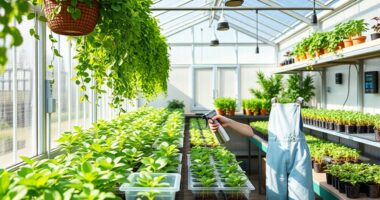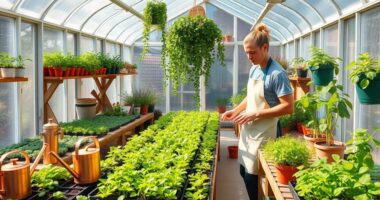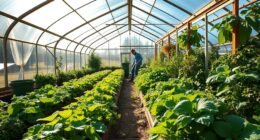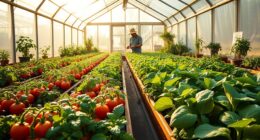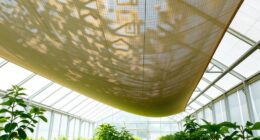Choosing between soil and container gardening in greenhouses depends on what you want. Soil gardening offers benefits like natural moisture retention and healthy roots but requires regular management and testing. Container gardening gives you more control over soil conditions and watering, although containers dry out faster and need close attention. Both options have pros and cons, so understanding their differences helps you optimize plant growth—stick with us to discover more insights.
Key Takeaways
- Soil gardening offers natural moisture retention and root stability but requires regular amendments and testing for optimal conditions.
- Container gardening provides precise control over soil conditions and environment, enabling customization but demands vigilant watering.
- Soil gardening benefits from natural buffering capacity, reducing disease risk, while container setups need careful moisture management to prevent root issues.
- Roots in containers tend to be densely packed, necessitating management to prevent constriction, whereas soil allows more natural root expansion.
- Both methods impact plant health differently; soil gardening offers stability through natural soil, while containers enable tailored conditions for specific plant needs.

When deciding how to grow your plants, understanding the differences between soil gardening and container gardening is crucial. Each method offers unique advantages and challenges, especially inside a greenhouse environment. Soil gardening involves working with ground plots, where the natural qualities of the soil influence plant growth. In contrast, container gardening allows you to control the environment more precisely by using pots or containers filled with soil or potting mix. This choice impacts several aspects of plant health, particularly water retention and root development, which are critical to your success.
With soil gardening, water retention can be both an advantage and a challenge. Natural soil often holds moisture well, reducing the frequency of watering needed. However, if the soil is too dense or poorly drained, excess water can lead to root rot and other diseases. Good soil structure promotes healthy root development, encouraging roots to spread out and access nutrients more efficiently. When you work in soil, you benefit from its natural buffering capacity, which stabilizes moisture levels and provides a stable environment for roots to grow deep. Nonetheless, you need to regularly amend and test your soil to ensure it’s balanced for your plants’ needs.
Container gardening gives you more control over water retention. Because containers are limited in size, they tend to dry out faster than ground soil, requiring you to monitor moisture levels closely. Using the right potting mix—one with good drainage yet capable of holding sufficient moisture—becomes essential. Proper watering techniques help prevent both under- and overwatering, which can stunt root development or cause root rot. Container roots tend to develop more densely around the edges of the pots, which can be beneficial for certain plants but might restrict overall root expansion if not managed properly. You can also customize containers with different soil mixes, adjusting water retention properties to match specific plant species, giving you flexibility that soil gardening lacks.
Frequently Asked Questions
Which Gardening Method Is More Cost-Effective Long-Term?
Container gardening is generally more cost-effective long-term because it requires less initial investment and offers better control over soil quality, reducing ongoing expenses. You can reuse containers and tailor soil mixes, which helps with cost savings. While soil gardening may seem cheaper initially, it might lead to higher maintenance costs over time. Consider your budget considerations carefully, and choose the method that aligns best with your financial goals and gardening needs.
Can Soil or Containers Better Control Pests in Greenhouses?
Using containers generally offers better pest management and contamination prevention in your greenhouse. Containers create a barrier that reduces soil-borne pests and diseases, making it easier to monitor and control infestations. They also allow you to use sterilized or pest-free soil, minimizing contamination risks. With soil, pests can easily hide underground, making pest control more challenging. So, opting for containers gives you more control over pest issues and maintains a healthier environment for your plants.
How Do Soil and Containers Impact Plant Growth Speed?
Your plant growth speed can be dramatically influenced by soil or containers. Soil often fosters robust root development and better nutrient absorption, leading to faster growth. Containers, on the other hand, can limit root expansion but allow precise control over nutrients, which can also accelerate growth if managed well. Ultimately, your choice affects how quickly your plants mature, so consider your space and goals to optimize growth rates.
Are There Specific Crops Suited Exclusively for One Method?
Yes, certain crops are better suited for one method due to crop specialization and plant compatibility. For example, delicate herbs like basil thrive in containers, offering better control over soil and watering. Root vegetables such as carrots prefer soil for stability and space. You should choose the method based on your crop’s needs, ensuring ideal growth by matching plant requirements with soil or container conditions.
What Environmental Factors Influence the Choice Between Soil and Containers?
You should consider environmental factors like temperature, humidity, and light when choosing between soil and containers. Soil nutrients naturally support plants, but containers require you to carefully select container materials that influence drainage and heat retention. If your greenhouse experiences fluctuating temperatures or high humidity, containers can offer better control, while soil may be preferable in stable conditions for sustained nutrient availability.
Conclusion
Whether you prefer soil or container gardening in your greenhouse, the choice often comes down to what fits your space and style. Sometimes, a simple pot can surprise you with a bountiful harvest, just like discovering a hidden gem in your garden. Both methods have their perks and quirks—it’s all about experimenting and finding what works best for you. So, next time you plant, remember, the best garden is the one you enjoy tending most.


